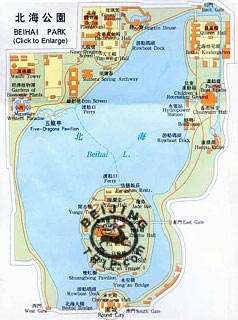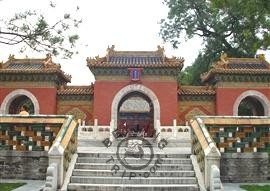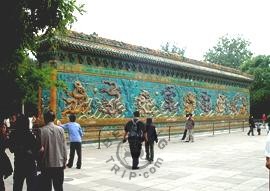 Baihai Park is situated in the Xicheng District and has a history of more than 1,000 years. This park was built up through five dynasties, the Liao (916-1125), the Jin (1115-1234), the Yuan (1271-1368), the Ming (1368-1644) and the Qing (1644-1911). Though it was a royal garden, it remains grand with a hint of exquisite elegance as well. It covers an area of 69 hectares (171 acres), with over a half covered by water. The whole park can be divided into four scenic areas: Qionghua Islet (Jade Flower Islet), Circular City, the eastern bank area and the northern bank area.
Baihai Park is situated in the Xicheng District and has a history of more than 1,000 years. This park was built up through five dynasties, the Liao (916-1125), the Jin (1115-1234), the Yuan (1271-1368), the Ming (1368-1644) and the Qing (1644-1911). Though it was a royal garden, it remains grand with a hint of exquisite elegance as well. It covers an area of 69 hectares (171 acres), with over a half covered by water. The whole park can be divided into four scenic areas: Qionghua Islet (Jade Flower Islet), Circular City, the eastern bank area and the northern bank area.
The Qionghua Islet which is densely distributed with halls, rockeries and pavilions stands at the centre of the park. The Yong'an Temple (Temple of Everlasting Peace) is the largest building complex which is composed of several halls, a bell tower and a drum tower. The temple used to be a place of worship for the emperors and their empresses. A white pagoda which stands out on the top of the islet is the symbol of the park. This Lamaist pagoda, 35.9 meters (117.8 feet ) high was built in 1651 where Buddhist lections, alms bowl and sarira remains of the Buddha's body are laid. West of the temple are the halls and pavilions where emperors of the Qing Dynasty had a rest, discussed official business or amused themselves. In the north of the islet, there is a two-storey corridor that offers an extensive view.
 In the southeast of the park, the Circular City is surrounded by a wall and is in fact an exquisite garden. The Chengguang Hall with yellow glazed tiles and green glazed eaves is quite dignified. Emperors of the Ming Dynasty (1368-1644) watched firework displays on it. Since the Qing Dynasty, it has been converted into a Buddhist chapel. A statue of Buddha that is carved out of a whole piece of white jade is enshrined in the main hall. In front of the Chengguang Hall, there is pavilion with a huge wine vessel laid out. The urn is engraved with a dragon in cloud and a sea horse on waves which was once used to store the wine by Kublai Khan, the first and brave emperor of the Yuan Dynasty. Both the pine and cypress tree are around 700~800 years old, so it is worth taking a closer look.
In the southeast of the park, the Circular City is surrounded by a wall and is in fact an exquisite garden. The Chengguang Hall with yellow glazed tiles and green glazed eaves is quite dignified. Emperors of the Ming Dynasty (1368-1644) watched firework displays on it. Since the Qing Dynasty, it has been converted into a Buddhist chapel. A statue of Buddha that is carved out of a whole piece of white jade is enshrined in the main hall. In front of the Chengguang Hall, there is pavilion with a huge wine vessel laid out. The urn is engraved with a dragon in cloud and a sea horse on waves which was once used to store the wine by Kublai Khan, the first and brave emperor of the Yuan Dynasty. Both the pine and cypress tree are around 700~800 years old, so it is worth taking a closer look.
As to the bank areas, the eastern bank enjoys its tranquility while the northern bank is very crowded with artificial structures. What is most conspicuous on the eastern bank is a lovely courtyard hidden in the trees. The courtyard was built as the former residence of emperors in the Qing Dynasty. The traditional buildings were elaborately designed, with a clear pool in the center.

On the northern bank area, the Five-Dragon Pavilions and the Nine-Dragon Wall are must-sees for visitors. The Five-Dragon Pavilions are said to be the place where the emperors went fishing and enjoyed the bright moon. The five pavilions are connected by a sigmate bridge, which resembles a swimming dragon when seen from distance. The Colored Glazed Pavilion is a religious building and quite a dazzling attraction. It has a bright yellow roof and 1,376 small statues of Buddha made of colored glaze are engraved on the outside wall. The Nine-Dragon Wall which was built in 1756 is the most delicate of China's three surviving nine-dragon walls. The wall, about 27 meters (89 feet) long is inlaid with colored glaze and has nine vivid dragons that play with pearls on either side.
|
Admission Fee:
|
CNY 10
|
April 1-October 31
|
|
November1-March 31
|
||
|
Opening Hours:
|
06:30-21:00
|
|
|
Bus Route:
|
5, 101, 103, 109, 124, 202, 211, 685, 814, 846 to Beihai
|
|
|
13, 24, 107, 111, 118, 204, 701, 810, 823, 850 to Beihai Beimen
|
||
 Beijing Parks and Lakes:
Beijing Parks and Lakes: